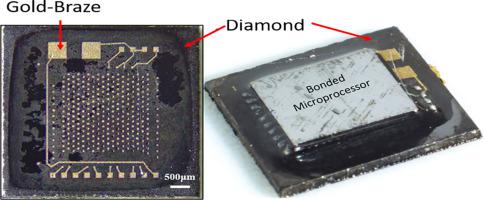当前位置:
X-MOL 学术
›
Diam. Relat. Mater.
›
论文详情
Our official English website, www.x-mol.net, welcomes your
feedback! (Note: you will need to create a separate account there.)
Improved wetting of gold active braze alloy on diamond for use in medical implants
Diamond and Related Materials ( IF 4.3 ) Pub Date : 2020-11-01 , DOI: 10.1016/j.diamond.2020.108089 Khatereh Edalati , Melanie Stamp , Kumaravelu Ganesan , Alastair Stacey , Gabriel Martin-Hardy , Réjean Fontaine , Steven Prawer , David J. Garrett
Diamond and Related Materials ( IF 4.3 ) Pub Date : 2020-11-01 , DOI: 10.1016/j.diamond.2020.108089 Khatereh Edalati , Melanie Stamp , Kumaravelu Ganesan , Alastair Stacey , Gabriel Martin-Hardy , Réjean Fontaine , Steven Prawer , David J. Garrett

|
Abstract Medical implants containing active electronics must have a leak-proof encapsulation to be certified as safe for human use. Implantable devices made from diamond demonstrated exceptionally long implantation lifetimes due to the outstanding biostability and biocompatibility of the material. However, since diamond does not melt and is therefore not weldable, forming joints between diamond components or embedding metallic wires and bonding pads within diamond is challenging. One method consists of using active braze alloys to bond diamond surfaces together. These active brazes comprise a precious metal alloy containing a carbide forming element that chemically bonds to the diamond as the braze metal melts. Silver-based active braze alloys are used successfully for brazing diamond in industrial applications, but silver is toxic to living tissue and, therefore unsuitable for use in implants. Gold active braze alloys (Au-ABA) are biocompatible but exhibit very poor wetting on the diamond. Here we demonstrate the use of molybdenum (Mo) and niobium (Nb) interlayers including single layers of Mo, Nb or Mo/Nb bilayer thin films as a solution to improve the wetting of Au-ABA on diamond surfaces. Theses interlayers provide for excellent penetration of the braze into the grooves and crevices in the diamond surfaces. We report on optimum recipes for the interlayer, both for the fabrication of weld lines and for the formation of smaller complex micro-structures and hermetic electrical feedthroughs.
中文翻译:

改善用于医疗植入物的金活性钎焊合金对金刚石的润湿
摘要 包含有源电子设备的医疗植入物必须具有防漏封装才能被证明对人类使用是安全的。由于材料出色的生物稳定性和生物相容性,由金刚石制成的可植入设备显示出非常长的植入寿命。然而,由于金刚石不会熔化,因此不可焊接,在金刚石部件之间形成接头或在金刚石内嵌入金属线和焊盘是具有挑战性的。一种方法包括使用活性钎焊合金将金刚石表面粘合在一起。这些活性钎焊包括贵金属合金,该合金含有碳化物形成元素,当钎焊金属熔化时,该元素与金刚石发生化学键合。银基活性钎焊合金已成功用于工业应用中的金刚石钎焊,但银对活组织有毒,因此不适用于植入物。金活性钎焊合金 (Au-ABA) 具有生物相容性,但对钻石的润湿性非常差。在这里,我们展示了使用钼 (Mo) 和铌 (Nb) 夹层(包括单层 Mo、Nb 或 Mo/Nb 双层薄膜)作为改善 Au-ABA 在金刚石表面上的润湿的解决方案。这些夹层使钎料能够很好地渗透到金刚石表面的凹槽和裂缝中。我们报告了中间层的最佳配方,包括焊接线的制造以及更小的复杂微结构和密封电气馈通的形成。在这里,我们展示了使用钼 (Mo) 和铌 (Nb) 夹层(包括单层 Mo、Nb 或 Mo/Nb 双层薄膜)作为改善 Au-ABA 在金刚石表面上的润湿的解决方案。这些夹层使钎料能够很好地渗透到金刚石表面的凹槽和裂缝中。我们报告了中间层的最佳配方,包括焊接线的制造以及更小的复杂微结构和密封电气馈通的形成。在这里,我们展示了使用钼 (Mo) 和铌 (Nb) 夹层(包括单层 Mo、Nb 或 Mo/Nb 双层薄膜)作为改善 Au-ABA 在金刚石表面上的润湿的解决方案。这些夹层使钎料能够很好地渗透到金刚石表面的凹槽和裂缝中。我们报告了中间层的最佳配方,包括焊接线的制造以及更小的复杂微结构和密封电气馈通的形成。
更新日期:2020-11-01
中文翻译:

改善用于医疗植入物的金活性钎焊合金对金刚石的润湿
摘要 包含有源电子设备的医疗植入物必须具有防漏封装才能被证明对人类使用是安全的。由于材料出色的生物稳定性和生物相容性,由金刚石制成的可植入设备显示出非常长的植入寿命。然而,由于金刚石不会熔化,因此不可焊接,在金刚石部件之间形成接头或在金刚石内嵌入金属线和焊盘是具有挑战性的。一种方法包括使用活性钎焊合金将金刚石表面粘合在一起。这些活性钎焊包括贵金属合金,该合金含有碳化物形成元素,当钎焊金属熔化时,该元素与金刚石发生化学键合。银基活性钎焊合金已成功用于工业应用中的金刚石钎焊,但银对活组织有毒,因此不适用于植入物。金活性钎焊合金 (Au-ABA) 具有生物相容性,但对钻石的润湿性非常差。在这里,我们展示了使用钼 (Mo) 和铌 (Nb) 夹层(包括单层 Mo、Nb 或 Mo/Nb 双层薄膜)作为改善 Au-ABA 在金刚石表面上的润湿的解决方案。这些夹层使钎料能够很好地渗透到金刚石表面的凹槽和裂缝中。我们报告了中间层的最佳配方,包括焊接线的制造以及更小的复杂微结构和密封电气馈通的形成。在这里,我们展示了使用钼 (Mo) 和铌 (Nb) 夹层(包括单层 Mo、Nb 或 Mo/Nb 双层薄膜)作为改善 Au-ABA 在金刚石表面上的润湿的解决方案。这些夹层使钎料能够很好地渗透到金刚石表面的凹槽和裂缝中。我们报告了中间层的最佳配方,包括焊接线的制造以及更小的复杂微结构和密封电气馈通的形成。在这里,我们展示了使用钼 (Mo) 和铌 (Nb) 夹层(包括单层 Mo、Nb 或 Mo/Nb 双层薄膜)作为改善 Au-ABA 在金刚石表面上的润湿的解决方案。这些夹层使钎料能够很好地渗透到金刚石表面的凹槽和裂缝中。我们报告了中间层的最佳配方,包括焊接线的制造以及更小的复杂微结构和密封电气馈通的形成。











































 京公网安备 11010802027423号
京公网安备 11010802027423号